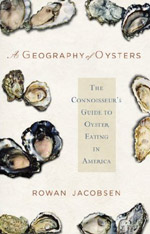What Kind of Oyster Eater Are You?
Different oysters suit different occasions and different people. If you haven’t yet been wowed by oysters, you may well have been dallying with the wrong ones. Maybe you hate the mouthful of salt you get with Eastern oysters and love supersweet Kumamotos. Maybe you like bold, gourmet oysters with brassy, lemony finishes. Or maybe that’s not you at all. Maybe, for you, heaven is a plate of petite oysters accompanied by Champagne, candlelight, and the perfect dinner companion. Don’t endure the duds in your search for a compatible oyster. Save yourself time, money, and heartbreak by picking your profile below, then finding your matches.
The Shrinking Violet
You’re not sure about this whole oyster thing, and need some convincing, preferably with the lightest-flavored, smallest, least intimidating oysters possible.
Beausoleils are the East Coast model, delicate, salty, with a fresh biscuit aroma. Many other New Brunswick oysters, such as La Saint Simons and Caraquets, also have a small size and clean finish. On the West Coast, Kumamotos are every beginner’s favorite oyster, and Kusshis are reliably small, pretty, creamy, and mild.
The Brine Hound
Bring on the salt! Chips, pickles, olives—you love ’em all. If you could drink seawater, you would.
Look for oysters grown in or near the open ocean. Maine and Massachusetts provide some of the briniest, with Pemaquids, Glidden Points, Wiannos, and Wellfleets leading the pack. Island Creeks, from Duxbury, can be extraordinarily salty, and Cuttyhunks come from an island off the coast of Cape Cod that has no rivers. Olde Salts, grown near Chincoteague Bay, are one of the few briny Virginia oysters. Pacifics tend to be less salty than Eastern oysters, but Snow Creeks fit the bill, and Willapa Bay is famous for its salty oysters. Bahia Falsas and El Cardons, from Baja California, may be the saltiest oysters on the planet.
The Sweet Tooth
Salt? Yuck! But there is nothing quite so divine as the creamy sweetness of a superplump oyster.
Forget Eastern oysters. The kind of sweetness you’re looking for can only be found in a Kumamoto—sweetest of the sweet—and some Pacifics. Totten Inlets are reliably sweet, Baywater Sweets and Hog Island Sweetwaters amazingly so. Nootka Sounds and Chelsea Gems also deliver the goods.
The Grail Seeker
Wellfleets? Westcotts? Been there, done that. You’ve had all the common oysters and want to taste new ones no one has heard of. And you’re willing to travel.
If you haven’t yet had the unique Olympia, that should go to the top of your list. It doesn’t travel well, so you’ll probably need to visit Washington State. Colville Bays are easy to find in PEI but rarely seen elsewhere. Sweet Drayton Harbor oysters aren’t sold commercially; you’ll need to visit the Community Oyster Farm in Washington State. Whale Rocks are rare Connecticut oysters from the Mystic River. Chiloes made some brief appearances in the United States but now are hiding out in Chile. Sydney Rock Oysters are the favorite Down Under and may begin appearing in the United States. To find the real grail, go to Brittany and get yourself a bona fide Belon.
The Connoisseur
You want the best oysters in the world, price be damned.
Tiny, intense Olympias are the demi-glace of oysters, a perfect reduction of tasty flavors. Penn Cove Selects and Hama Hamas are more satisfying in size, with the bright green flavors that mark the best Pacifics. Kumamotos have unmatched fruitiness—though Hog Island Sweetwaters give them a run for their money and balance the fruit with perfect brine. Westcott Bay Flats deliver a refined, metallic zing that can be found only in a European Flat. Among Eastern oysters, Colville Bays have full citrus flavor and perfect salinity, Glidden Points are big and briny. For mineral-rich, savory intensity, Moonstones, Oysterponds, and Widow’s Holes are your best bets. Some feel that a Totten Virginica combines the best of both coasts in one oyster.
The Wild One
Forget those hatchery-raised wimps, you want a natural-set oyster that survived the one-in-a-million journey from egg to adult.
Olympias are natural-set—and native, of course. Hama Hamas are still grown from natural sets in Hood Canal. Most Apalachicola oysters are completely wild, born and raised in the flats of Apalachicola Bay and harvested with tongs. Gulf oysters are generally wild, as are many Malpeques, Caraquets, Tatamagouches, Bras D’Ors, Martha’s Vineyards, and Chesapeakes. But if the call of the wild is what you’re after, consider harvesting your own. Many state parks, particularly in Washington State, have oyster seasons.
The Wino
Those potent, briny, musky oysters are as overblown as an Australian Shiraz. You like to savor oysters with wine, so you want subtle mineral flavors, not metal and salt and mud.
Kumamotos are Sauvignon Blanc’s best friend; their clean melon flavors bring out its fruit. Westcott Bay Petites and Stellar Bays are both creamy and mild, not too salty, with no clashing bitterness. Eastern oysters are tougher matches for wine, but buttery Watch Hills have a full-bodied flavor that can be terrific with sharp, flinty wines, and Rappahannock Rivers bring out the minerals in some white wines. Beausoleils have a supreme lightness that is heaven with Champagne.
The Bold
Bring on the tangiest, muskiest, biggest, most challenging oysters possible. You don’t scare easy.
Damariscotta Belons are your Everest. Snow Creek Flats are your K2. Any European Flat is going to test you. Large Pacifics can also have intense and exotic flavors, particularly those from southern Puget Sound. Skookums will push the musk as far as you want to take it. Hammersley Inlets aren’t far behind. Any extra-large oyster will deliver sheer chewing intimidation.
The Clean Freak
You prefer filter feeders from pristine waters.
Two Canadian oysters from opposite ends of the country grow in national parks: Raspberry Points in Prince Edward Island National Park and Imperial Eagle Channels in Pacific Rim National Park. Nootka Sounds grow in an area of British Columbia less populated than Pacific Rim National Park. Canoe Lagoons hail from Alaska’s 17-million-acre Tongass National Forest, where the bears outnumber the people. Drake’s Bays are screened from all of California by the bulk of Point Reyes National Seashore. Cuttyhunks live in solitary splendor on the deserted west end of Cuttyhunk Island, ten miles off the Massachusetts coast.
The Jeweler
You eat with your eyes as much as your belly, and you love the gemlike shells of some oysters.
Suspended culture—floating trays or lantern nets—is the best way to preserve the colors and patterns some oysters develop on their shells. Carlsbad Blonds display black-and-white fan patterns. Kusshis, Stellar Bays, and Hog Island Sweetwaters have smooth, deep, purple-black shells. Imperial Eagle Channels and Nootka Sounds, two oysters from West Vancouver Island, have art-deco swirls of pink, purple, and green. Oysters from Samish Bay, including Penn Cove Selects and Naked Roy’s Beach, have impressively fluted shells.
The Minister of Silly Names
For you, half the fun is the goofy things oysters are called.
Naked Roy’s Beach and Moonstone are named for nude beaches. Fanny Bays might as well be. Tatamagouche, Malagash Thrumcap, Nootka, and Hama Hama are just plain fun to say. Tomahawk has a certain retro charm. A Stingray is cool, a Kusshi is cute, and who could forget their first Carlsbad Blond?


